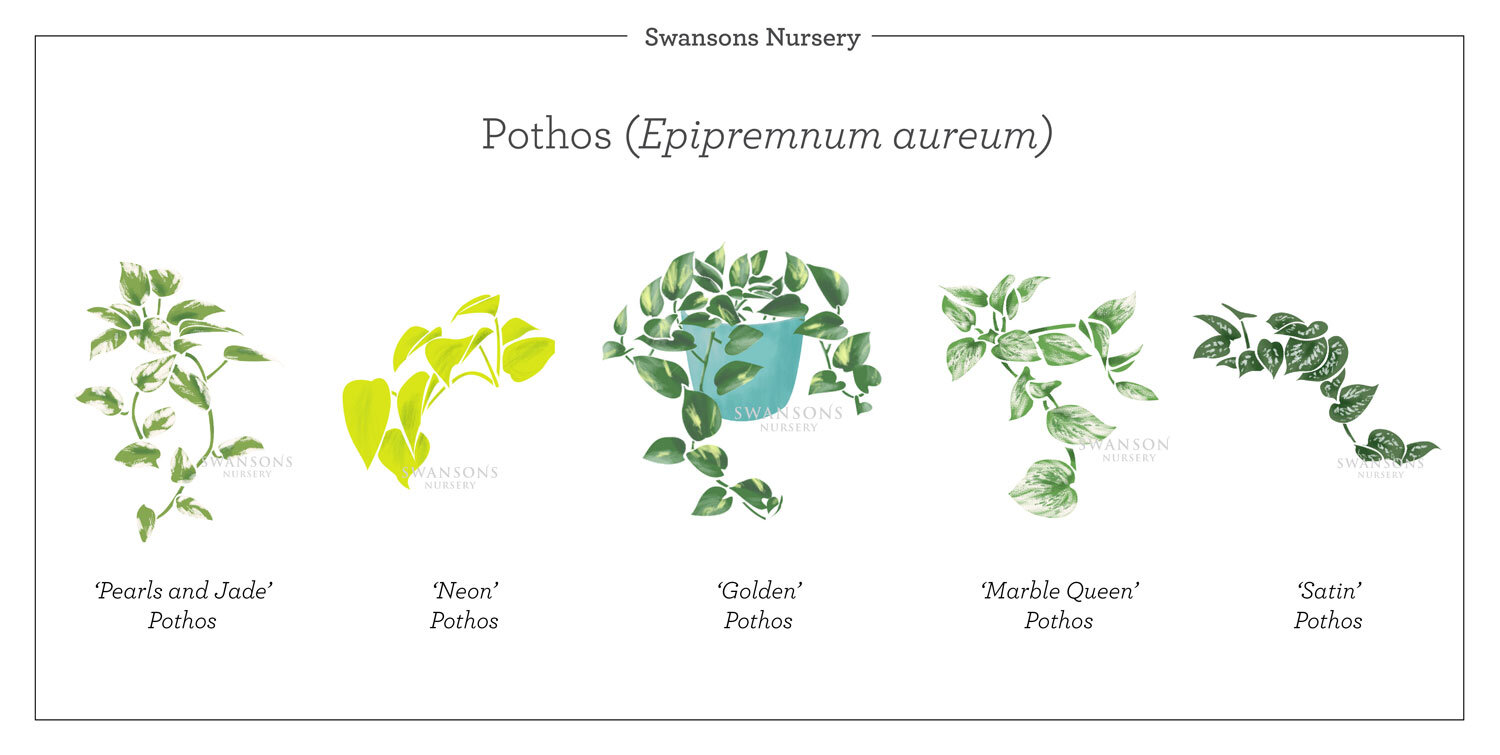Pothos
(Epipremnum aureum)
Pothos (Epipremnum aureum) is one of the easiest houseplants to grow and is a beautiful addition to any home or office. Best of all, pothos plants grow well in almost any situation! Native to Mo'orea, an island in French Polynesia, pothos is a trailing vine with glossy or satiny, heart-shaped leaves.
Golden Pothos
How to Care for Pothos
This fast-growing houseplant is perfect for beginners and seasoned indoor gardeners alike. Easy to care for and tolerant of many conditions, it looks beautiful trailing down from a bookcase or desk and can be trained up a trellis or across a wall to make a dramatic impact. Wrap around or tie to a trellis or gently lay the stems over nails or pushpins in the wall for support, if desired.
Water
Pothos plants like to dry out quite a bit between waterings. If you notice leaves yellowing or falling off, you may have waited too long. Dry, brown leaf edges also mean water more frequently. Be sure to drench the plant thoroughly each time you water (until water runs out of the drainage holes in the pot) and then let it dry before watering again.
Light
Pothos prefers bright indirect light (no direct sun) but will still grow in shadier spots and even under fluorescent lights. Without adequate light, it may become a bit leggy. Trim back the stems to help create a bushier silhouette. Variegated types may also lose their variegation and revert to all green in shady conditions. Satin pothos is very tolerant of low-light situations.
Fertilizer
Fertilize monthly in the spring and summer when the plant is actively growing.
Humidity & Temperature
While pothos likes higher humidity it will tolerate the drier air of most homes.
Satin Pothos
photo: The Spruce
Repotting
Since pothos plants are fast growers, eventually you will need to repot your plant. If you see roots growing out of the bottom of the pot or water runs immediately out of the drainage holes when you are watering, you’ll know it needs a repot.
Remove the plant from its pot and gently massage the roots to loosen them. Replant into a container that is no more than a couple of inches larger than the last using fresh houseplant soil. Don’t forget to give it a good soak when you’re done!
Propagating
Pothos are incredibly easy to propagate and, if you like to keep your plants bushy, you’ll have plenty of cut stems to experiment with! Simply trim off a length of stem, remove the leaves along the bottom 2”-3”, and put the stem in a jar of water. It will begin to grow roots very quickly.
Remember to add more water if it goes below root-level and to occasionally change the water entirely. A complete change about once every two weeks should suffice. Your cuttings can grow in water until they have a nice amount of roots, then plant them in a small pot with fresh houseplant soil.
More about Pothos
Pothos is considered one of the best indoor plants to purify the air, removing common toxins such as formaldehyde, xylene, and benzene.
Pothos is also called hunter’s robe, arum ivy, money plant, taro vine. It is also sometimes referred to as devil’s ivy because it is nearly impossible to kill and, in nature, can become invasive.
In its natural environment, pothos can quickly grow up trees, reaching over 60 feet tall.
You might find pothos mislabeled as Philodendron because both are trailing plants with heart-shaped leaves. Pothos belongs to the Epipremnum genus and philodendron to the Philodendron genus but they do share the same plant family: Araceae. Learn more about how to tell the two plants apart in this great article by The Spruce.
Pothos plants are considered toxic if ingested by pets or humans.
Neon Pothos
photo: modern plant life
Pothos Varieties
Here are some of the most popular Pothos varieties (not all varieties are continually available at Swansons)
Marble Queen Pothos (large leaves with striking green and white variegation)
Golden Pothos (the traditional pothos: green and yellow variegated, heart-shaped leaves)
Green Queen Pothos (a beautiful, dense shape with solid green leaves)
Neon Pothos (Bright, bright, bright! This neon-green vine stands out)
Pearls and Jade (a smaller-leafed variety with white speckles on green leaves)
Satin Pothos (satiny leaves with silver and deep green variegation. Very tolerant of low light)
Read our other indoor plant profiles: All About Snake Plant and All About Dracaena





